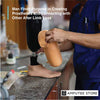4 Tips to Help Manage Anxiety
Hearing about anxiety disorders is becoming commonplace. According to the Anxiety and Depression Association of America, 40 million adults in the US are affected by anxiety disorders. What is anxiety? And why does it hold so much power in the lives of 40 million adults?

Understanding anxiety
From a psychological standpoint, we experience anxiety when we overestimate the likelihood of something terrible happening and underestimate our ability to handle it. This happens because humans are hard-wired to pay more attention to threatening information than positive information. This phenomenon is also known as “negativity bias.”
Negativity bias was crucial for the survival of our hunter-gatherer ancestors, who relied on this instinct to avoid the constant threat of attack. However, this is where the mind-body connection comes into play. As the mind goes into threat detection mode, the body responds by producing adrenaline, making it easier to escape a threat. And when this happens, you experience anxiety—an exaggeration of the risk of a threat, whether imagined or real.
While this response to an unknown threat is helpful in a hunter-gatherer society, most modern societies have little need. So, how can we manage our fight-or-flight response and improve our quality of life?
Optimism: The antidote to anxiety
Positivity or optimism may seem overrated these days, what with the glut of self-help books, podcasts, and vlogs that promote it. However, according to studies, a healthy dose of optimism can help reduce anxiety.
From a psychological standpoint, optimism is a mix of confidence, positivity thinking, goal persistence, and feelings of hope. It is not limited to what many people misconstrue as having a rose-colored-glasses point-of-view.
Healthy, positive thinking can help, especially when you are experiencing a setback, which you can interpret as something temporary rather than permanent. To be optimistic in this sense is to acknowledge the bad things in life but choose not to dwell on them. This is different from denial, which can be unhealthy.
So, how can you leverage on the power of optimism to reduce or calm anxiety? We have four tips below.
1. Rewire your brain
Since negativity bias is deeply entrenched in our biology, rewiring your brain or changing your thinking patterns can help reduce anxiety.
A study titled, “Optimism and the Brain: Trait Optimism Mediates the Protective Role of the Orbitofrontal Cortex Gray Matter Volume against Anxiety,” which was published in the journal Social, Cognitive and Affective Neuroscience, found that positivity had physiological effects.
The study focuses on the orbitofrontal cortex (OFC), a brain region located in the prefrontal cortex behind your eyes. This area, which plays a vital role in integrating information from the emotional, intellectual, and rational centers, has long been known to play a role in anxiety disorders. It is also bigger and more developed in people who tend to be more optimistic and less anxious.
Developing your OFC requires adopting new ways of thinking. You can do this by keeping a journal and assessing how your brain processes setbacks. Or you can work with a psychologist, who can expertly guide you through the complicated process.
2. State a positive intention at the beginning of your day
Writing down your goals first thing in the morning is a powerful way to get you into a positive, goal-driven mindset. You can do this by identifying three things that you need to get done during the day.
Another way to start your day on a positive note is to keep a gratitude journal. This exercise allows you to appreciate what you have. For example, instead of thinking that you “have to go to your job,” you can say that you “get to do your job.”
3. Strip your fears
Another great way to rein in your overly worried brain is by stripping down your fears. Understanding and gaining information about your worries is the antidote to fear.
A distorted perception of a situation fuels anxiety. But when you strip your fears down and take the time to understand the odds of it happening, you can put things into perspective.
We recommend working with a professional psychologist for this. He or she can help you accurately assess the likelihood of a terrible event happening as well as your ability to handle it.
4. Surround yourself with people who make you feel good
This fourth tip is simple that even a child instinctively does it: Surround yourself with people who make you feel safe and calm. This can include someone in your family or a good friend.
This tip works because humans are hard-wired to be a part of a community. But as social isolation becomes increasingly common today, anxiety cases also rise. So, keep a list of these people near you at all times, so you know who you can talk to when anxiety hits.
But if you don’t have a great support system, we recommend that you start surrounding yourself with optimists. This works because you’ll be able to witness first-hand how they explain their stories and events.
If you’re currently in a situation where you experience chronic anxiety, we suggest re-evaluating your options. Exposure to chronic anxiety and stress can severely affect your quality of life. It can also increase your risk for certain diseases, such as diabetes and heart issues.
What do you think of these tips? Which ones have you tried, and how did they work for you? Please share your thoughts with the community in the comments section below.









































































